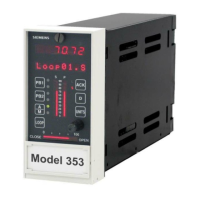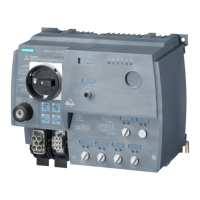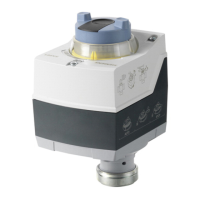UM353-1 Function Blocks
March 2003
3-79
3.2.76 PCOM - Phase COMmunication
The Phase Communication PCOM function block, in
firmware 1.30 and higher, is available on a one per loop
basis to enable communication with a higher level
device, such as a PC running a batch management
software program. When the controller configuration is
structured such that logic operations are partitioned in
small phase operations, the PCOM block facilitates the
interface between the logic controlling the overall phase
operations for the batch and the logic performing the
control logic for each phase.
The logic performed by the PCOM block is detailed in
Boolean form in Figure 3-1. Network communication
can be either Modbus or LIL (Local Instrument Link).
Details are listed in the Network Communications
section. The LOOP # configured in the ODC or ODS
function block for the loop determines the location of
the status word and the status coils in the Modbus
mapping. Communication states are represented in
Figure 3-1, on the next page, using the symbols shown
below. Modbus states are mapped in coils and LIL
states mapped into two 16-bit status word as shown
below. Three global channels are used to send out the
two status words and an integer value from 1-7 that
represents the status of the PCOM block: 1=ABORTED,
2=DONE, 3=HELD, 4=RUN, 5=INTRLK, 6=READY, 7=EMER OR. The location of the first channel is
configured using the LIL CHAN parameter, represented by channel z in the LIL mapping tables.
Read/Write States
R 0
W 1
W 0
START
Read States
R 1/0
RUN
Each communication state is read as a 1 or 0. Using Modbus, a write of a 1 (W1) or a 0 (W0) will affect the
communication state as defined by the associated logic in Figure 3-1. The W1 or W0 is equivalent to a Mask ON or
a Mask OFF using LIL commands. All unconfigured inputs will be treated as low (0) except OK, RD, RN and HE
which will be treated as high (1). Three of the output states, EO (“EMERG”), IK (“INTRLK”), and FD
(“FAILED”) can be configured for priorities 0-5. This will affect the flashing, etc. as previously described for other
controller status conditions. These states also have unacknowledged bits as detailed in status word 2. Conditions
that require acknowledging can be acknowledged by either using the local faceplate ACK button or by writing to
the individual not acknowledged bit or the Not Ack’d PCOM bit.
BIT 1514131211109876543210
START
HOLD
RESTART
RESET
ABORT
INIT_OK
DFAIL
PCOMP
READY
RUN
HELD
DONE
ABORTED
NAME
1
0
R
R
R
R
R
R
R
R
R
R
W
R
R/W R/W
R/WR/W
WWR/WW
W
RRR/WRR
Status Word 1
EMERG
BIT 15 14 13 12 11 10 9 8 7 6 5 4 3210
NAME
1
0
R
R
EMERG (EO)
INTRLK (IK)
R
R
Not Ack'd EO
Not Ack'd IK
R/WR/W
R
R
FAILED (FD)
R
R
Not Ack'd FD
R/W
R
ACTIVE PCOM
R
R
Not Ack'd PCOM
R/W
R
Status Word 2
E
merg.
O
R
Phase COMunication
EO
Phase
Communication
PCOM
EO
INT_
OK
OK
P
IO
RO
E
E
merg.
O
verride
PRIOR
ity ... 0,1,2,3,4,5 (4)
P
hase_
F
ail
PF
IK
I
nterloc
K
ed
FD
F
aile
D
R
T
U
P
N
I
INPUT EO
............
loop tag.block tag.output (null)
EO
R
ea
D
y
RD
R
u
N
RN
HE
ld
HE
D
o
N
e
DN
RS
R
e
S
et
EN
EN
abled
ST
ST
art
HO
HO
ld
P
T
U
P
N
I
O
T
U
P
N
I
K
F
T
U
P
N
I
T
U
P
N
IRD
RN
D
T
U
P
N
I
H
T
U
P
N
I
E
N
INPUT PF
............
loop tag.block tag.output (null)
INPUT OK
............
loop tag.block tag.output
(null)
INPUT RN
............
loop tag.block tag.output
(null)
INPUT RD
............
loop tag.block tag.output (null)
INPUT DN
............
loop tag.block tag.output
(null)
INPUT HE
............
loop tag.block tag.output (null)
LIL CHAN
LIL CHAN
nel ........................ 008 to 253
(null)
SEN
E
xec.
S
eq.
N
o. .................... 000 to 250 (000)
E
merg.
O
R
I
nterloc
K
ed
PRIOR
ity ........... 0,1,2,3,4,5 (4)
D
evice
F
ail
PRIOR
ity ............ 0,1,2,3,4,5 (4)
P
IO
R
R
P
IO
R
R
I
K
DF

